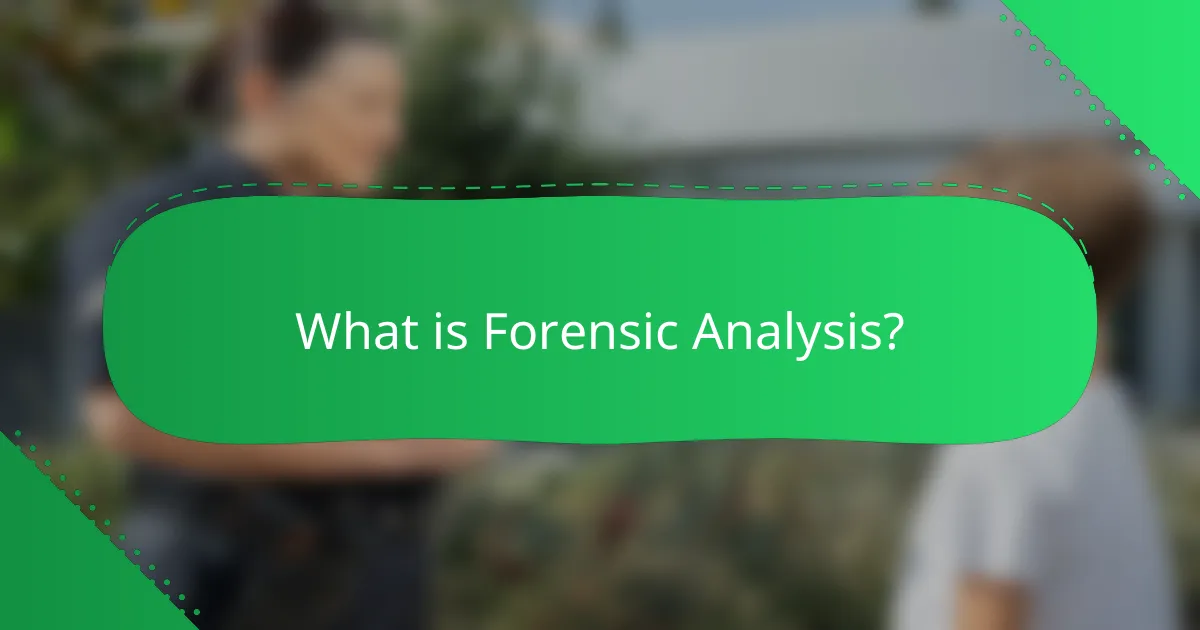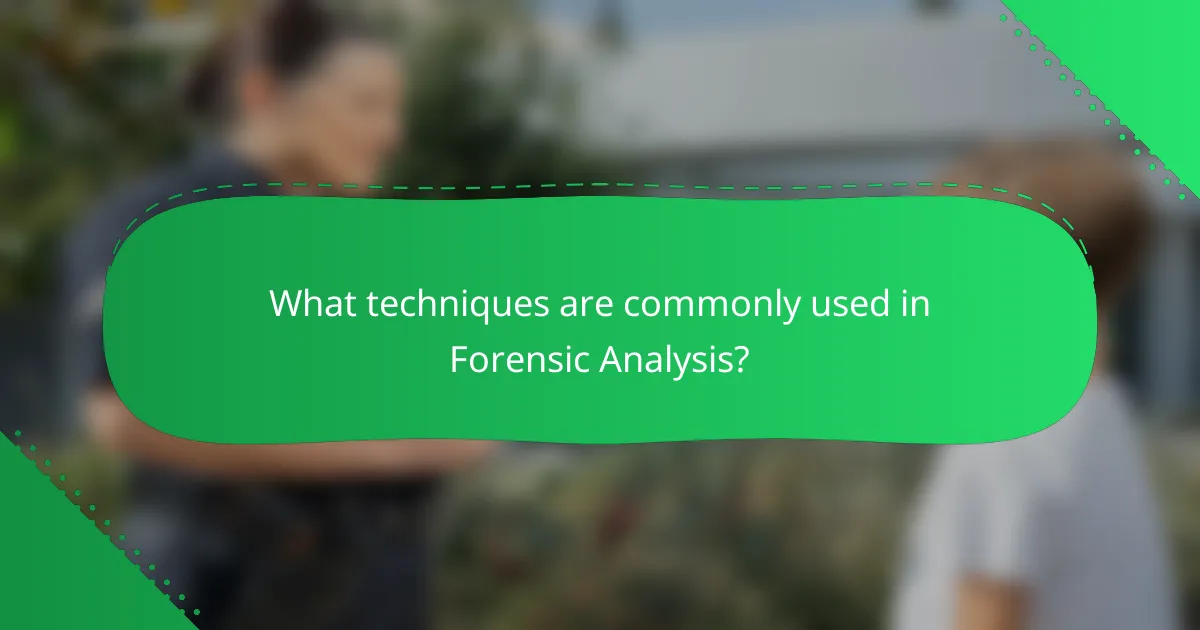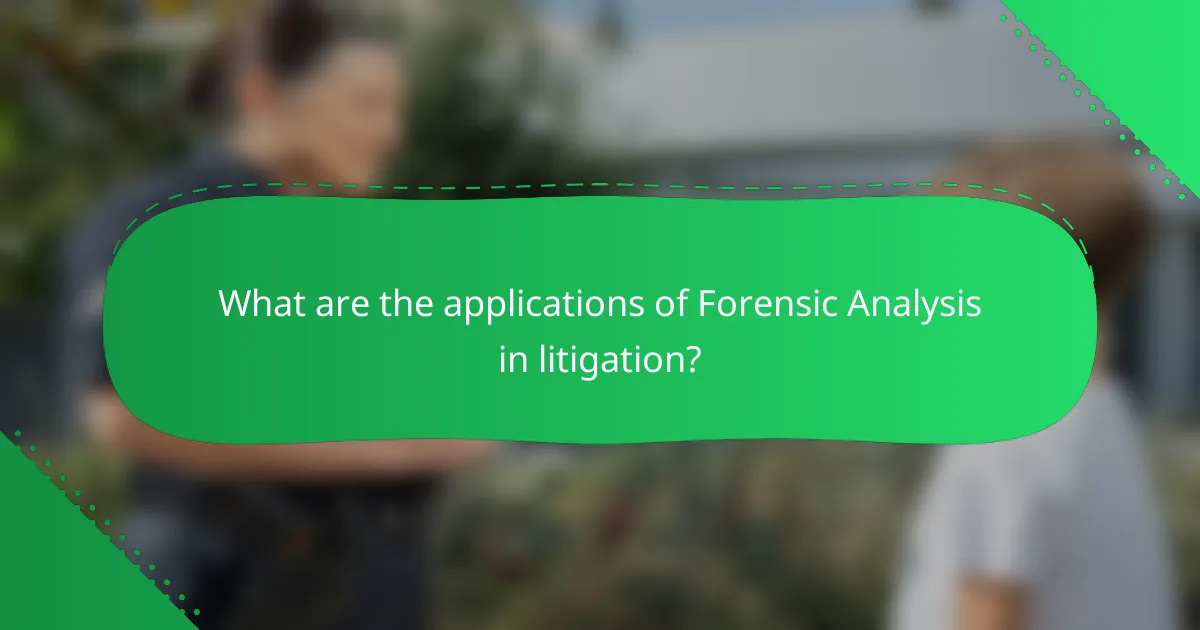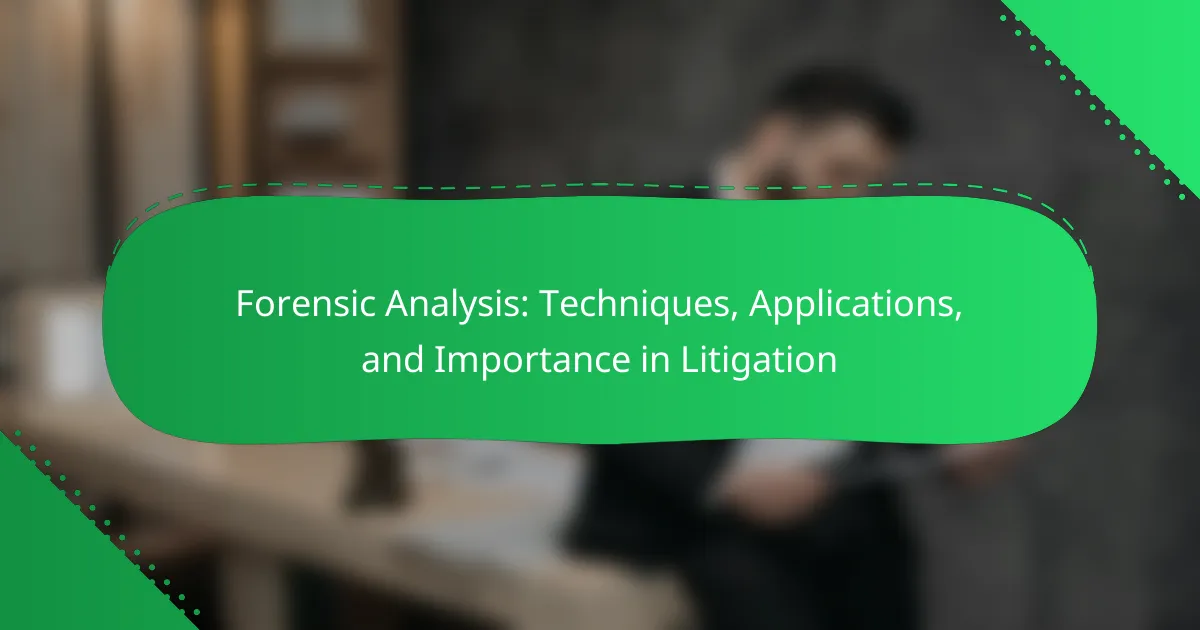Forensic analysis is the scientific examination of physical evidence to investigate crimes, utilizing methods such as fingerprint analysis, DNA profiling, and digital forensics. This article explores the various techniques employed in forensic analysis, their applications in legal proceedings, and the critical role they play in establishing facts that support or refute claims in court. It also addresses the challenges and limitations faced by forensic analysts, including the potential for human error and the variability in analytical techniques. The importance of forensic analysis in enhancing the credibility of evidence and influencing jury decisions is emphasized throughout the discussion.

What is Forensic Analysis?
Forensic analysis is the application of scientific methods to investigate crimes. It involves collecting, preserving, and examining physical evidence. This evidence can include fingerprints, DNA, and digital data. Forensic analysts use various techniques to analyze this evidence. These techniques can include chemical analysis, microscopy, and statistical analysis. The results of forensic analysis can be critical in criminal investigations and legal proceedings. Forensic analysis helps establish facts that support or refute claims in court. Its use has been validated by numerous successful criminal convictions based on forensic evidence.
How is Forensic Analysis defined in the context of litigation?
Forensic analysis in the context of litigation is the application of scientific methods to investigate evidence for legal proceedings. It involves collecting, preserving, and examining physical evidence to support or refute claims in court cases. Forensic analysis can include various disciplines such as DNA analysis, fingerprinting, and digital forensics. These techniques help establish facts and provide objective evidence that can influence judicial outcomes. The reliability of forensic analysis is supported by established protocols and standards in the forensic community. Courts often rely on expert testimony to validate the findings derived from forensic analysis.
What are the historical developments of Forensic Analysis?
Forensic analysis has evolved significantly over centuries. The origins trace back to ancient civilizations, where basic techniques were used for crime solving. In the 19th century, advancements in chemistry led to the development of toxicology. This period marked the introduction of scientific methods to crime investigation. In 1892, Sir Francis Galton published a book on fingerprinting, establishing it as a reliable identification method. The first forensic laboratory was established in 1910 in France, standardizing forensic practices. DNA analysis emerged in the 1980s, revolutionizing forensic science with its accuracy in identifying individuals. Technological advancements continue to enhance forensic analysis, including digital forensics and advanced imaging techniques. These developments have solidified forensic analysis as a critical component in modern criminal justice systems.
What are the core principles underlying Forensic Analysis?
The core principles underlying forensic analysis include the preservation of evidence, the chain of custody, and the application of scientific methods. Preservation of evidence ensures that physical and digital items remain intact and unaltered. The chain of custody documents the handling of evidence from collection to presentation in court. Scientific methods involve systematic processes for analyzing evidence to ensure accuracy and reliability. These principles are essential for maintaining the integrity of forensic investigations. Adherence to these principles supports the legal process and strengthens the validity of findings in litigation.
Why is Forensic Analysis crucial in legal proceedings?
Forensic analysis is crucial in legal proceedings because it provides objective evidence that can confirm or refute claims made in court. This type of analysis applies scientific methods to investigate crime scenes, analyze evidence, and reconstruct events. Forensic evidence can include DNA testing, fingerprint analysis, and digital forensics. Such evidence is often pivotal in establishing guilt or innocence. Studies show that cases with forensic evidence have higher conviction rates. For instance, a report by the National Academy of Sciences highlighted that forensic science enhances the reliability of the judicial process. Ultimately, forensic analysis helps ensure that justice is served based on factual, scientific findings.
How does Forensic Analysis impact the outcome of a case?
Forensic analysis significantly impacts the outcome of a case by providing objective evidence. This evidence can confirm or refute claims made by parties involved. Techniques such as DNA analysis, fingerprinting, and ballistics can link suspects to crime scenes. Forensic evidence often plays a critical role in jury decisions. According to a study published in the Journal of Forensic Sciences, cases with forensic evidence are more likely to result in convictions. Furthermore, forensic analysis can also help exonerate innocent individuals. In high-profile cases, forensic findings can influence public perception and media coverage. Ultimately, the accuracy and reliability of forensic analysis can determine the justice served in a legal proceeding.
What role does Forensic Analysis play in ensuring justice?
Forensic analysis plays a critical role in ensuring justice by providing scientific evidence in legal cases. It helps to establish facts that can confirm or refute claims made by parties involved in litigation. Forensic techniques include DNA analysis, fingerprint comparison, and digital forensics, which can link suspects to crime scenes. The reliability of forensic evidence often influences the outcomes of trials. Studies show that juries are more likely to convict based on strong forensic evidence. Additionally, forensic analysis can exonerate innocent individuals by revealing new information. The integration of forensic science in the legal system enhances the accuracy of verdicts. Overall, forensic analysis serves as a cornerstone in the pursuit of justice.

What techniques are commonly used in Forensic Analysis?
Common techniques used in forensic analysis include fingerprint analysis, DNA profiling, and ballistics examination. Fingerprint analysis involves comparing unique patterns found on surfaces to identify individuals. DNA profiling utilizes genetic material to establish identity or familial relationships. Ballistics examination examines firearms and ammunition to link them to specific incidents. Other techniques include toxicology, which analyzes bodily fluids for substances, and digital forensics, which recovers data from electronic devices. Each technique plays a crucial role in investigations and legal proceedings, providing evidence that can support or refute claims in court.
What are the main types of forensic techniques?
The main types of forensic techniques include DNA analysis, fingerprint analysis, and ballistics analysis. DNA analysis identifies individuals based on their unique genetic makeup. This technique has a high degree of accuracy and is commonly used in criminal investigations. Fingerprint analysis examines the unique patterns of ridges and valleys on an individual’s fingers. This method has been used for over a century and remains a reliable identification tool. Ballistics analysis studies firearms and ammunition to determine the trajectory and origin of projectiles. This technique is crucial in solving shooting-related crimes. Each of these forensic techniques plays a vital role in the criminal justice system, providing evidence that can confirm or refute allegations in court.
How does DNA analysis contribute to Forensic Analysis?
DNA analysis significantly enhances forensic analysis by providing accurate identification of individuals. It allows forensic experts to match biological samples from crime scenes with suspects. This process relies on the unique genetic makeup of individuals. DNA can be extracted from various sources, including blood, hair, and saliva. The probability of two individuals sharing the same DNA profile is extremely low, often cited as 1 in a billion. This high level of specificity aids in both convicting the guilty and exonerating the innocent. Additionally, DNA evidence can link a suspect to multiple crime scenes or victims. Its reliability has made it a cornerstone of modern forensic science.
What role do fingerprinting and ballistics play in forensic investigations?
Fingerprinting and ballistics play crucial roles in forensic investigations. Fingerprinting is used to identify individuals based on unique patterns in their fingerprints. This method can link a suspect to a crime scene through latent prints left on surfaces. Ballistics involves the study of firearms and ammunition. It helps determine the type of weapon used in a crime and the trajectory of bullets.
For example, ballistic analysis can match a bullet to a specific firearm through its unique markings. Both techniques provide critical evidence that can support or refute a suspect’s involvement in a crime. Their accuracy and reliability have been validated in numerous court cases, making them essential tools in forensic science.
How do forensic experts apply these techniques?
Forensic experts apply various techniques through systematic investigation and analysis. They collect evidence from crime scenes, including biological samples and physical materials. Experts use techniques such as fingerprint analysis, DNA profiling, and ballistics to identify suspects. They employ chemical analysis to detect substances like drugs or explosives. Forensic experts also analyze digital evidence from electronic devices. They document their findings in detailed reports for use in legal proceedings. Courtroom testimony is often provided to explain their methods and conclusions. This application of techniques aids in establishing facts in litigation.
What is the process of collecting forensic evidence?
The process of collecting forensic evidence involves systematic steps to ensure integrity and reliability. First, the crime scene must be secured to prevent contamination. Next, investigators document the scene through photographs and sketches. They then collect physical evidence, such as fingerprints, hair, and fibers, using proper techniques. Each item is carefully labeled and stored to maintain a chain of custody. Specialized tools may be used to gather trace evidence from surfaces. Additionally, biological samples, like blood or saliva, are collected with sterile equipment. Finally, all evidence is transported to a forensic laboratory for analysis. This meticulous process is crucial to uphold the validity of evidence in legal proceedings.
How is forensic evidence analyzed and interpreted?
Forensic evidence is analyzed and interpreted through systematic processes involving collection, examination, and evaluation. Initially, forensic experts collect evidence from crime scenes, ensuring proper chain of custody. This evidence may include biological samples, fingerprints, or digital data. Next, forensic scientists conduct examinations using various techniques, such as DNA analysis or chemical testing. Each method provides specific insights into the evidence’s origin and relevance.
After examination, experts interpret the results in the context of the case. They assess the significance of findings to establish connections between the evidence and individuals or events. This interpretation is critical for legal proceedings, as it helps establish facts and support arguments in court.
Studies indicate that the reliability of forensic evidence is influenced by the methods used and the expertise of the analysts. Properly analyzed forensic evidence can significantly impact case outcomes, providing crucial information for both prosecution and defense.

What are the applications of Forensic Analysis in litigation?
Forensic analysis has several applications in litigation. It is used to gather and analyze evidence for legal cases. This includes examining physical evidence like fingerprints, DNA, and ballistic materials. Forensic experts provide testimony based on their findings. Their insights can influence jury decisions significantly. Additionally, forensic analysis aids in fraud investigations and digital crime cases. It helps establish timelines and identify suspects. Overall, forensic analysis enhances the credibility of evidence presented in court.
How is Forensic Analysis utilized in criminal cases?
Forensic analysis is utilized in criminal cases to collect, preserve, and analyze physical evidence. This process helps establish connections between suspects, victims, and crime scenes. Techniques include DNA profiling, fingerprint analysis, and ballistic testing. Each method provides crucial insights into criminal activities. For instance, DNA evidence can link a suspect to a crime scene with high accuracy. Fingerprint analysis can identify individuals based on unique patterns. Ballistic testing can match firearms to specific bullets. The results of forensic analysis are often presented in court as expert testimony. This evidence can significantly influence the outcome of a trial.
What specific forensic methods are employed in homicide investigations?
Forensic methods employed in homicide investigations include DNA analysis, fingerprint analysis, ballistics, and toxicology. DNA analysis helps identify victims and suspects through biological samples. Fingerprint analysis matches prints found at crime scenes to known individuals. Ballistics examines firearms and ammunition to determine weapon use. Toxicology tests body fluids for substances that may indicate cause of death. Each method provides critical evidence to support investigations.
How does Forensic Analysis assist in fraud cases?
Forensic analysis assists in fraud cases by providing systematic examination of evidence. It identifies fraudulent activities through data analysis and digital forensics. Forensic experts analyze financial records to uncover discrepancies. They also trace the flow of funds to detect illicit transactions. Additionally, forensic analysis employs techniques like document examination to verify authenticity. This process helps establish the timeline of events related to fraud. Studies show that forensic analysis increases the likelihood of successful fraud prosecutions. For instance, cases with forensic evidence have higher conviction rates compared to those without.
What are the implications of Forensic Analysis in civil litigation?
Forensic analysis significantly impacts civil litigation by providing objective evidence. This evidence can strengthen or weaken a party’s case. Forensic techniques include document examination, digital forensics, and expert witness testimony. Such analyses help establish facts and clarify disputes. They can also reveal hidden information relevant to the case. Courts often rely on forensic findings to make informed decisions. The admissibility of forensic evidence is governed by legal standards. This ensures that the evidence presented is credible and reliable.
How does Forensic Analysis support personal injury claims?
Forensic analysis supports personal injury claims by providing scientific evidence to substantiate claims. It involves the examination of physical evidence, such as accident scenes, injuries, and medical records. Forensic experts analyze this evidence to determine the cause and extent of injuries. They can reconstruct events leading to the injury using techniques like accident reconstruction and biomechanics. This analysis offers objective data that can be critical in court. Studies show that cases with forensic evidence have higher success rates in litigation. Forensic analysis also helps in identifying liability by clarifying the sequence of events. Overall, it enhances the credibility of personal injury claims through detailed, factual analysis.
What role does Forensic Analysis play in corporate disputes?
Forensic analysis plays a critical role in corporate disputes by providing objective evidence that can clarify complex issues. It involves the examination of financial records, communications, and other relevant data to uncover fraud or misconduct. Forensic experts analyze data patterns and anomalies to support claims or defenses in litigation. Their findings can be crucial in negotiations or court proceedings. Companies often rely on forensic analysis to ensure compliance and mitigate risks. According to a study by the Association of Certified Fraud Examiners, organizations lose an estimated 5% of their revenue to fraud each year. This highlights the importance of forensic analysis in identifying and addressing such issues effectively.

What are the challenges and limitations of Forensic Analysis?
Forensic analysis faces several challenges and limitations. One significant challenge is the potential for human error during evidence collection and analysis. This can lead to inaccurate results that may affect legal outcomes. Another limitation is the variability in forensic techniques, which can yield different results depending on the method used. Additionally, forensic analysis often relies on the quality of the evidence collected. Poor quality evidence can compromise the integrity of the analysis. There are also limitations related to the availability of advanced technology and resources. Some forensic labs may lack access to the latest tools, affecting their analytical capabilities. Furthermore, the interpretation of forensic evidence can be subjective, leading to differing conclusions among experts. These challenges highlight the complexities involved in forensic analysis within the legal system.
What common challenges do forensic experts face?
Forensic experts face several common challenges in their work. One major challenge is the complexity of evidence collection. This often involves navigating crime scenes that may be hazardous or contaminated. Another challenge is maintaining the chain of custody for evidence. Proper documentation is crucial to ensure the integrity of the evidence. Forensic experts also encounter difficulties in analyzing diverse types of evidence. This includes biological, digital, and chemical samples that require specialized knowledge. Additionally, they must contend with legal pressures and deadlines. Courts often impose strict timelines for evidence presentation. Finally, forensic experts face the challenge of communicating their findings effectively. Their analyses must be understandable to non-experts in a courtroom setting. These challenges can impact the overall effectiveness of forensic analysis in litigation.
How does the quality of evidence affect forensic outcomes?
The quality of evidence significantly influences forensic outcomes. High-quality evidence leads to accurate conclusions in forensic analysis. Reliable and well-preserved evidence enhances the integrity of investigations. Conversely, poor-quality evidence can result in incorrect interpretations and wrongful convictions. For instance, contaminated or improperly collected samples may yield unreliable results. Studies show that forensic errors often stem from inadequate evidence handling. Thus, maintaining evidence quality is crucial for effective legal proceedings.
What are the limitations of forensic techniques in litigation?
Forensic techniques in litigation have several limitations. First, the reliability of forensic evidence can be questioned. Various techniques may lack standardization and validation. This can lead to inconsistent results across different cases. Second, forensic evidence can be subject to human error. Misinterpretation or mishandling of evidence can compromise its integrity. Third, the cost of forensic analysis can be prohibitive. Not all parties in litigation can afford extensive forensic testing. Fourth, some forensic techniques may not be admissible in court. Legal standards for admissibility can vary, affecting the use of such evidence. Lastly, forensic evidence can be misrepresented in court. This can lead to jury misunderstanding and influence case outcomes.
What ethical considerations surround Forensic Analysis?
Ethical considerations in forensic analysis include the integrity of evidence, the rights of individuals, and the potential for bias. Maintaining evidence integrity is crucial to ensure accurate results. Analysts must follow protocols to prevent contamination or tampering. Respecting individual rights involves obtaining consent and ensuring privacy. Analysts should avoid conflicts of interest that may influence their objectivity. Bias can arise from personal beliefs or external pressures. Training in ethics is essential for forensic professionals. Research shows that ethical lapses can lead to wrongful convictions. Therefore, adherence to ethical standards is vital in forensic analysis.
How can forensic evidence be misused in legal contexts?
Forensic evidence can be misused in legal contexts through improper collection, analysis, or presentation. Contamination of evidence can occur during collection, leading to unreliable results. Misinterpretation of forensic data can result from lack of training or experience among analysts. Additionally, biases may influence the interpretation of evidence, skewing outcomes. In some cases, evidence may be fabricated or altered to support a particular narrative. Courts may also face challenges with the admissibility of forensic evidence due to lack of standardization in methods. These issues can undermine the integrity of the legal process and lead to wrongful convictions or acquittals.
What are the best practices for maintaining integrity in Forensic Analysis?
Best practices for maintaining integrity in forensic analysis include strict chain of custody protocols. This ensures that evidence is collected, handled, and stored properly. Documentation must be thorough and accurate at every stage. All procedures should be standardized and followed consistently. Analysts should undergo regular training to stay updated on best practices. Utilizing validated methods and tools is essential for reliable results. Independent verification of findings can enhance credibility. Transparency in reporting and methodology fosters trust in the analysis. These practices are supported by guidelines from organizations like the Scientific Working Group on Digital Evidence (SWGDE).
What best practices should legal professionals follow regarding Forensic Analysis?
Legal professionals should adhere to several best practices regarding forensic analysis. First, they must ensure the integrity of evidence during collection and handling. This includes using proper protocols to avoid contamination or alteration. Second, legal professionals should engage qualified forensic experts for analysis. These experts provide accurate and reliable results. Third, maintaining a clear chain of custody is essential. This documentation tracks the evidence from collection to presentation in court. Fourth, legal professionals should stay updated on forensic technology advancements. New techniques can improve the accuracy and efficiency of forensic analysis. Finally, they need to communicate findings clearly to judges and juries. Effective communication ensures that complex forensic concepts are understood in legal contexts. These practices enhance the credibility and effectiveness of forensic evidence in litigation.
Forensic analysis is the scientific examination of evidence related to criminal investigations and legal proceedings. This article covers the definition, historical developments, core principles, and significance of forensic analysis in litigation. Key techniques such as DNA analysis, fingerprinting, and ballistics are discussed, along with their applications in criminal and civil cases, including personal injury claims and corporate disputes. The article also addresses challenges, limitations, and ethical considerations associated with forensic analysis, emphasizing best practices for maintaining the integrity of evidence in legal contexts.



